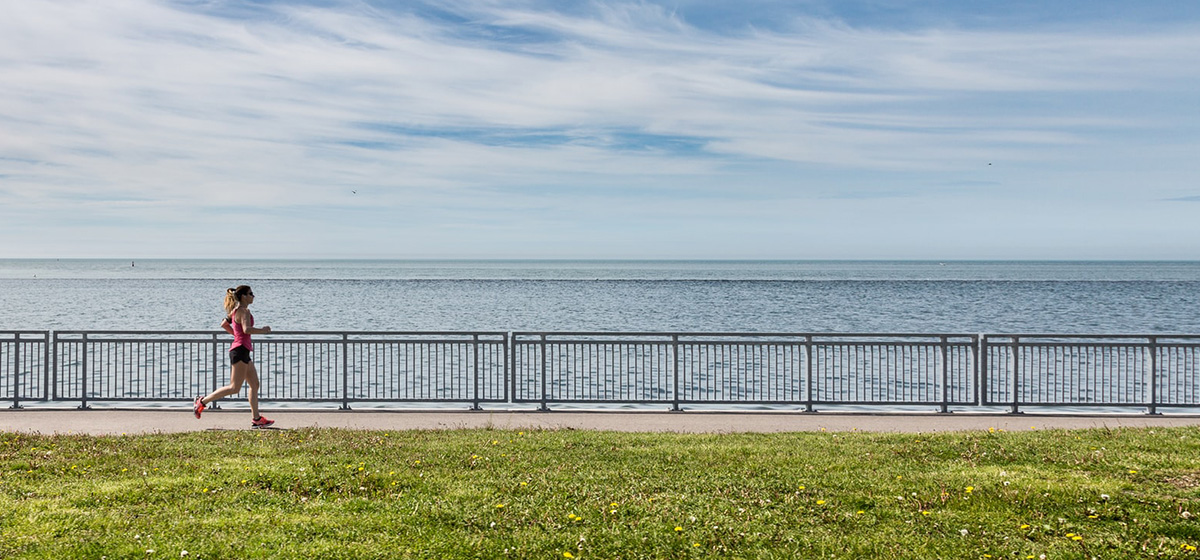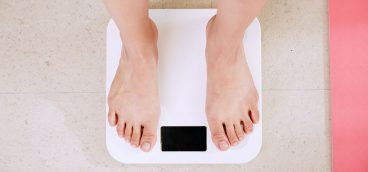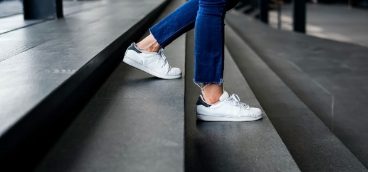Exercising in the Heat: Tips to Stay Safe

Question: “My primary forms of exercise are jogging and biking. Are there any special precautions I should take when exercising in extremely hot and humid conditions?”
Four primary factors—air temperature, humidity, wind velocity and thermal radiation—interact to determine the level of heat stress imposed on the human body when exercising outdoors. For example, jogging on a sunny 90-degree (Fahrenheit) day with little or no wind produces significantly greater heat stress than would exercising in the same temperature with a 15 mile-per-hour wind and heavy cloud cover. Likewise, a person is more apt to overheat when exercising in an 80-plus degree temperature with high humidity than at the same temperature but a significantly lower humidity. High humidity impairs our ability to dissipate heat through sweating, which is the body’s primary cooling mechanism.
Normal human body temperature is approximately 98.6 degrees Fahrenheit and must remain within relatively narrow limits. An increase or decrease of only a few degrees either way can be dangerous to health and well-being. During exercise, the movement of muscles produces heat which causes a slight rise in body temperature. In response to the increase, heart rate speeds up, in part to supply the working muscles with oxygen, but also to deliver more blood to the skin surface for heat release. At the same time, the sweating response is initiated to assist with cooling. If core body temperature does not cool sufficiently in response to those measures, then heat-related issues may arise.
Heat cramps are least serious and generally take the form of spasms in the muscles performing the bulk of the exercise. For example, it is not uncommon for soccer players who may run several miles during a match to experience cramping in the calf or hamstring muscles on a hot, humid day. Heat cramps generally result from dehydration and mineral losses incurred during heavy sweating, although other factors may also play a role.
Heat exhaustion can result when the body’s cooling systems fail to adequately dissipate heat. During heavy aerobic exercise performed in a hot, humid environment, a competition arises between the skin and muscles performing the work for a limited blood supply. Muscles require oxygen carried by the blood to sustain the activity, while the skin uses blood to facilitate heat loss and keep the body cool. Heat exhaustion occurs when the cardiovascular system does not distribute an adequate supply of blood to the skin for heat dissipation, or when total blood volume decreases significantly due to fluid loss. Although anyone can experience heat exhaustion, unfit individuals are most susceptible. Symptoms can include dizziness, clumsiness, extreme fatigue, vomiting, fainting and higher than normal exercise heart rate. Heat exhaustion is a much more serious condition than heat cramps. If unchecked, it can lead to heat stroke.
Heat stroke is a potentially life-threatening condition caused by a total collapse of the body’s heat dissipating mechanisms. Symptoms may include hot and dry skin, rapid pulse, a body temperature in excess of 104 degrees, confusion and unconsciousness. Rapid cooling of the body is critical to survival. This is usually done by placing the person in a bath of cold water or by wrapping in wet sheets. Immediate attention by trained medical personnel is critical to survival.
Prevention
Prevention is always preferred to treatment. The American College of Sports Medicine (ACSM) and Centers for Disease Control and Prevention (CDC) suggest the following general guidelines if you plan to exercise in a hot, humid environment.
- First, check with your physician to make sure there are no medical issues that would restrict you from exercising in hot and humid conditions.
- Stay hydrated. Drink plenty of liquids, even more than thirst indicates. Signs of dehydration may occur with as little as a 1 percent decrease in body weight.
- If the temperature is above 80 degrees and the humidity is above 75 percent, it may be beneficial to exercise indoors.
- Exercise early in the day or later in the evening after sundown when it is cooler.
- Improve your level of aerobic fitness. Individuals who are more aerobically fit can adapt better when exercising in extreme heat.
- Wear loose and lightweight clothing.
- Wear sunscreen. Sunburn affects your body’s ability to cool down.
Treatment
People who experience symptoms of heat-related issues should immediately stop exercising and move to a shaded or air-conditioned area. They should remove any excess clothing or equipment, consume cold beverages, and if, available, place a damp and chilled cloth around their neck. If the person continues to feel extremely hot and begins to have trouble concentrating, then they should contact emergency medical services immediately.
In conclusion, if you take necessary precautions, there is no need to feel anxious or worried about exercising out-of-doors during the hot and humid summer months. Recognizing the symptoms of heat stress, being pro-active and taking preventative measures, and knowing appropriate treatment options will reduce the probability of you ever experiencing a serious heat-related issue.




